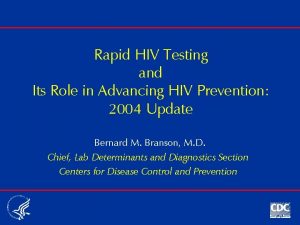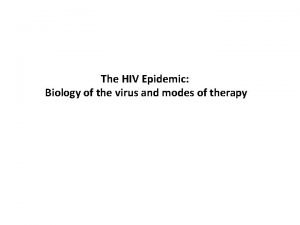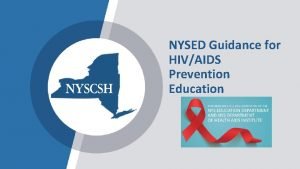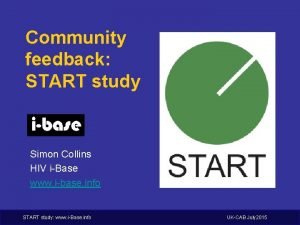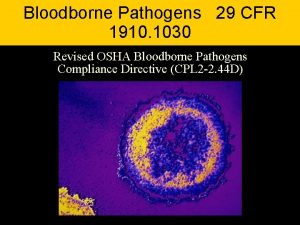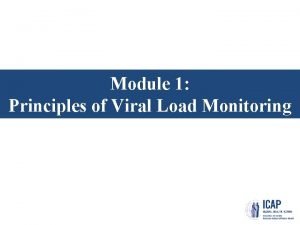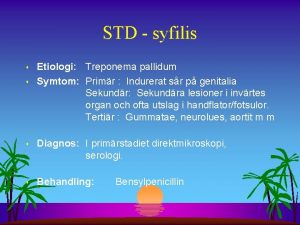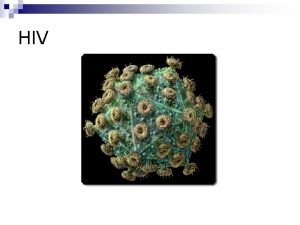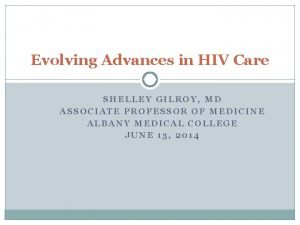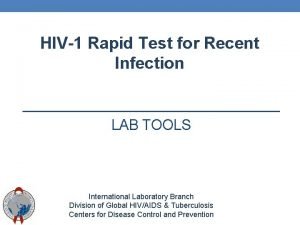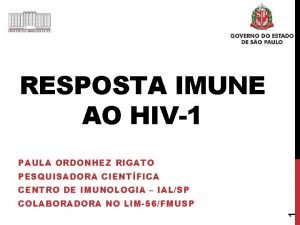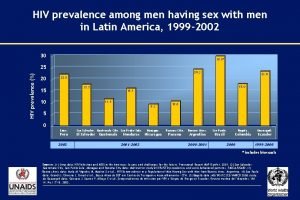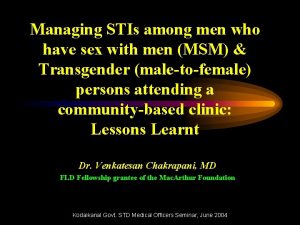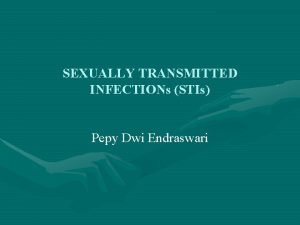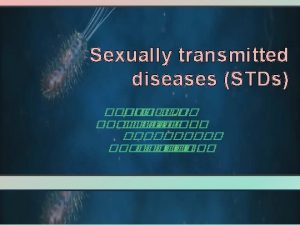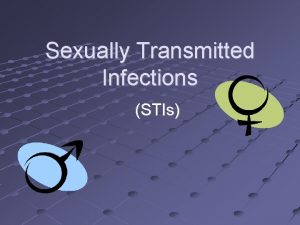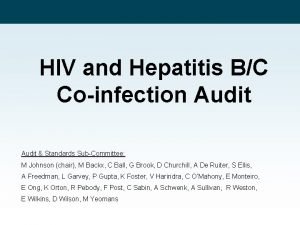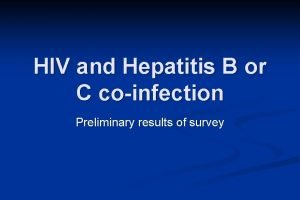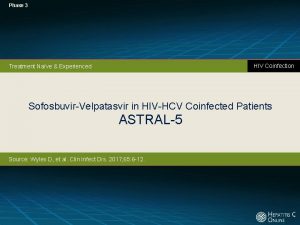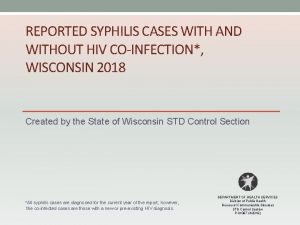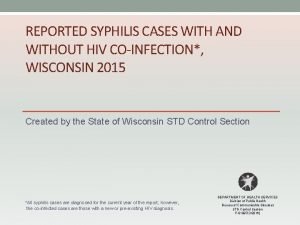Coinfection of STIs with HIV among men who













- Slides: 13

Co-infection of STIs with HIV among men who have sex with men (MSM) in Beijing, China Xiaoyan Zhang State Key Laboratory for Infectious Disease Prevention and Control National Center for AIDS/STD Control and Prevention, China CDC

AGENDA • Introduction about MSM related research in China • Study design • Results • Demographic characteristics; • Sexual risks • Prevalence of HIV-1 and other infections • Prevalent HIV-1 subtypes • Conclusion

Introduction • 2006 Chinese National report: – Morbidity and mortality of STIs including HIV/AIDS, syphilis and gonorrhea, increased by 3. 5 % and 7. 2 %, – New HIV infections: 70, 000 cases, >40% by sexual transmission. • The effect of STIs on HIV-1 transmission are not clear: – Syphilis and urethritis were reported to result in a decrease of CD 4+ T cell and an increase of HIV-viral load, both of which later improved after the STIs treatment. – A study on an Amsterdam cohort of young HIV negative MSM : The incidence of syphilis and gonorrhoea has increased among young homosexual men since 1995, while HIV incidence has remained stable. • MSM are vulnerable to infection by HIV and other STIs because of their high risky behaviors.

From Previous Study • Our previous study found (Beijing, 2005) : infection rates of HCV and syphilis among MSM significantly increased when co-infected with HIV: – HCV: 1. 5% to 17. 7%, – Syphilis: 11. 2% to 35. 29%. – co-infected patients showed lower CD 4 and higher HIV viral load comparing with HIV mono-infected MSM • The infection rate and effect of other STIs on HIV-infection and transmission among MSM in Beijing has not been established.

Study design • Study subjects (n=753) : MSM recruited at VCT clinic at Chaoyang District CDC in Beijing with written informed consent. • Eligibility criteria: – Age: should be 18 years old or older; – Residency: should be registered as a Beijing resident; – Sexual preference: should have a life time history of sex with other men. • Questionnaire (30 -minute) : to collect the information about demographic characteristics as well as their engagement in risky behaviors. • Lab testing: – Screening testing: to detect the infection of HIV, Syphilis, Ureaplasma Urealyticum (UU), Chlamydia Trachomatis (CT ), HCV and Toxoplasma gondii. – HIV+MSM: CD 4+ cell count and viral load. – HIV-1 subtypes analysis

Demographic characteristics • Age: from 18 to 55 years old (median: 25). • All stayed in Beijing in the past 6 months, however, 74. 25% had migrated from other provinces. • Education: More than half (51%) were college educated or above; 35% had attended senior high school; 14% received a junior high school education or below. • Occupations: near 70 % were office clerks (including small business owners, government employees, and college students); 15% were labor workers; 10 % were unemployed; and 5% were others.

Marriage status 1. Most of them were single (70. 5%); 2. Cohabited with homosexual partners (19. 3%); 3. Married a woman(<10%), but only 4. 2% were still in the marriage, 3. 1% of them were separated from their wife , 2. 4% had divorced. Self-reported sexual behaviors indicated that about 41% of MSM had engaged in sex with both men and women, which suggested a potential risk for HIV-1 transmission between MSM and their heterosexual partners

Sex practices by HIV status All sexual activities were investigated among MSM with their male sexual partners

Co-infections with HIV in MSM in Beijing • The co-infection rate was much higher in HIV+ MSM compared with those in HIV- MSM. • HIV+MSM were most frequently co-infected with syphilis.

Subtype Analysis Subtypes samples % US. B 31 63. 3 CRF 01_AE 2 4 CRF 15_01 B 1 2 Complexes 15 30. 6 Total 49 100 In the MSM population, HIV-1 has evolved with diversities, partially because of crosssexual HIV transmission. Mainly found in heterosexually and IDUs acquired HIV+ people Combination Gag BJMSM 1709 01 AE BJMSM 1107 01 AE US. B BJMSM 1708 US. B BJMSM 1543 01 AE C BJMSM 1624 01 AE C BJMSM 1703 CRF 07_BC US. B Mainly found in IDUs HIV+ people Env Pol US. B 01 AE US. B

gag env pol

Conclusion • HIV+ MSM were more likely to have more male sex partners and more unprotected insertive anal sex. • STIs may be associated with an increased risk of HIV infection and transmission. HIV+MSM were with much higher co-infection rate, and they were most frequently co-infected with syphilis. • There is a potential risk for HIV transmission between MSM and their heterosexual partners (women). • The HIV-1 strains prevalent among this MSM population have evolved with diversities, partially because of cross-sexual interaction with other high risky groups for HIV infection. • The data suggest that the strategy for HIV/AIDS prevention and control among MSM should be combined with STDs in China. It also underscores the importance of continuing efforts to educate and inform HIV-infected patients about the importance of safe sex.

Acknowledgement • State Key Laboratory for Infectious Disease Prevention and Control, • National Center for AIDS/STD Control and Prevention, China CDC – Yiming Shao – Xiaoyan Zhang – Shenwei Li – Yuhua Ruan • Chaoyang District CDC Beijing, China – Xiaoxi Zhang, – Chen Wang, – Wang Hengwei, – Dongliang Li


